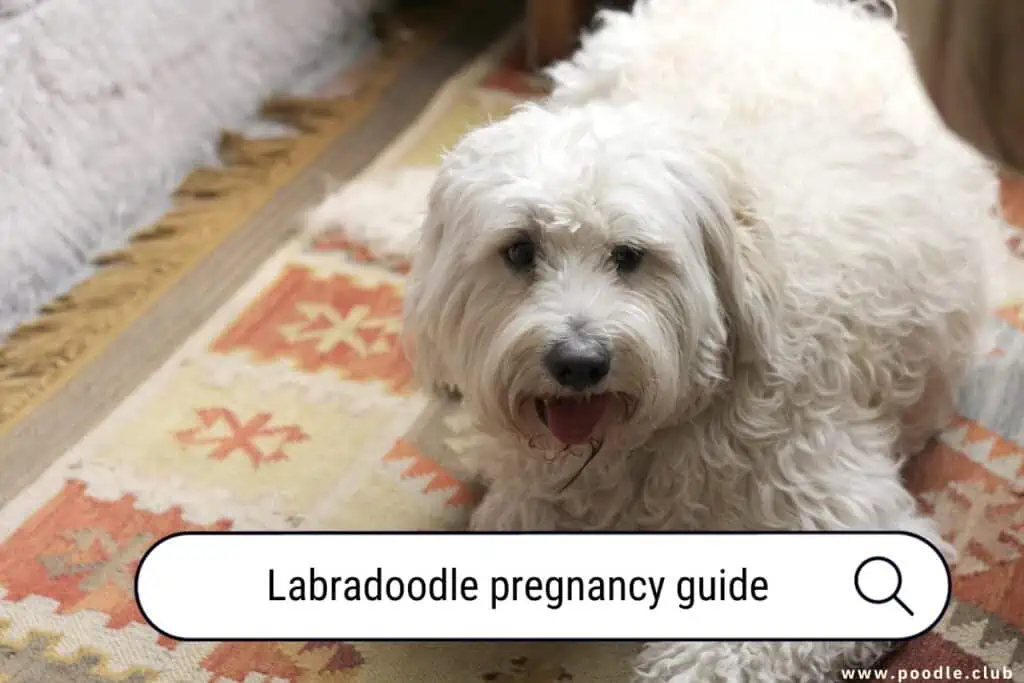Labradoodle Pregnancy Guide: Essential Tips for a Healthy Journey
As a Labradoodle owner, it’s essential to know how to properly care for your dog during pregnancy. Ensuring the health and well-being of the mother and her puppies is a top priority, and this guide is designed to help you navigate this journey with confidence.
From pre-pregnancy health and care to understanding the signs of pregnancy and preparing for the arrival of puppies, we’ll delve into all aspects of Labradoodle pregnancy in this article.
First, it’s essential to understand Labradoodle pregnancy basics and their unique breed traits before diving into the details. Having a solid foundation of knowledge about this breed will serve as a valuable tool in guiding your Labradoodle through a healthy pregnancy and beyond.

Lastly, it’s important to be aware of post-pregnancy care and the steps needed to transition your Labradoodle back to her everyday life. By implementing a proper care plan, both mother and pups can thrive in a healthy and nurturing environment.
Key Takeaways
- A comprehensive guide to supporting your Labradoodle throughout her pregnancy journey.
- Familiarize yourself with the Labradoodle breed and pregnancy signs to keep mother and puppies healthy.
- Implement a proper care plan, including post-pregnancy, to ensure the well-being of your Labradoodle and her offspring.
Understanding Labradoodle Pregnancy
As a Labradoodle owner, knowing about your dog’s pregnancy is essential. Recognizing the signs and symptoms can help you provide the best care to your pregnant Labradoodle. This guide aims to update your knowledge and answer common questions regarding Labradoodle pregnancy.

Signs and Symptoms
Your Labradoodle might show some noticeable changes when she’s pregnant. Early signs include increased appetite, weight gain, and a swollen belly. Behavioral changes, such as being more affectionate or seeking isolation, are also common.
Similar to humans, dogs may sometimes experience morning sickness and discharge from the vulva.
Gestation Period
The gestation period for Labradoodles is approximately 59 to 65 days. You can confirm pregnancy through an ultrasound, usually after 25 days from the last mating date. This can also provide a count of the embryos in the uterus.
Ovulation and Body Temperature
A Labradoodle’s ovulation occurs around 12 days into the heat cycle, and its body temperature experiences a slight drop in the 24 hours preceding whelping. Monitoring your dog’s temperature regularly may help you predict the whelping date.
Ensure that you provide your pregnant Labradoodle with proper nutrition, exercise, and a comfortable environment for her. Additionally, regular check-ups with your veterinarian can help identify any complications and ensure a smooth pregnancy journey for your beloved companion.
Pre-Pregnancy Health and Care

Nutrition Prior to Pregnancy
Proper nutrition is crucial for your Labradoodle before pregnancy. Feeding your dog a balanced diet ensures she receives the essential nutrients needed for a healthy pregnancy. Choose high-quality dog food that meets AAFCO standards and contains the necessary vitamins, minerals, and proteins.
Adjust your dog’s feeding schedule to maintain a healthy weight, as obesity can cause complications during pregnancy.
PuppySpot is a reputable dog marketplace where you can browse and find compatible puppies right from the comfort of your home. They have placed over 200,000 puppies into homes in the US!
It’s important to avoid any sudden changes in your Labradoodle’s diet. Gradually introduce any new food and remember to consult your veterinarian for personalized advice based on your dog’s age, weight, and overall health.
Exercise and Activity Level
An active lifestyle is vital for your Labradoodle’s overall well-being, including pre-pregnancy health. Regular exercise helps to maintain a healthy weight and reduces stress. Aim to engage your dog in daily physical activities such as:
- Walks or jogs.
- Fetch or catch games.
- Dog park visits.
However, avoid over-exertion, as this can be detrimental to your dog’s health. Monitor your Labradoodle’s energy levels and adjust the activity schedule as needed. Always provide your dog with access to fresh water and shelter during outdoor activities.
Remember, a healthy pre-pregnancy routine sets the foundation for a successful pregnancy. Prioritize proper nutrition and exercise for your Labradoodle, and consult your veterinarian for any specific concerns or adjustments as necessary.
Pregnancy Development and Signs

Physical Changes
During your Labradoodle’s pregnancy, you’ll notice several physical changes. Her nipples and teats may become more prominent, and her abdomen will gradually enlarge as the puppies grow. It’s essential to keep an eye on these changes, but don’t be overly concerned if they’re not very noticeable—some dogs don’t show significant signs until the final weeks of pregnancy.
As your Labradoodle approaches her due date, her abdomen may appear even more swollen. This is a normal part of the pregnancy process but monitor for signs of discomfort or difficulty moving.
Behavioral Changes
Beside the physical changes, your Labradoodle may also show behavioral changes during her pregnancy. Her temperament might become more sensitive or moody, which is typical as her hormones fluctuate. She will likely have varying levels of energy, with some days being more lethargic than others.
You might also observe changes in her appetite, such as increased hunger or pickiness about what she eats. It’s essential to provide your pregnant Labradoodle with a high-quality diet to support her needs and those of her growing puppies.
Towards the end of the pregnancy, your Labradoodle may begin nesting behaviors—searching for a quiet, comfortable spot to give birth. Keep an eye on her during this time and prepare a nesting area for her if she’s struggling to find one herself. This is an excellent opportunity to provide support and comfort to your pregnant Labradoodle as she prepares for the arrival of her puppies.
Post-Pregnancy Care

Feeding and Nutrition After Birth
After your Labradoodle gives birth, proper feeding and nutrition become essential for both the mother and the puppies. Initially, the mother’s milk will provide the puppies with all the essential nutrients they need. Monitor the mother’s food consumption to ensure she is eating well, as her calorie intake will need to increase significantly to produce enough milk for her puppies.
Consider gradually introducing a high-quality puppy food to the mother’s diet, starting a few weeks before her due date. This will support her milk production and maintain her health during nursing. Once the puppies reach about three to four weeks of age, you can begin to wean them off their mother’s milk and introduce them to the same high-quality puppy food.
It’s crucial to provide fresh water for the mother at all times. This will help her to stay hydrated and maintain good milk supply.
Health of the Mother and Puppies
As a Labradoodle owner, it’s your responsibility to monitor the health of both the mother and her puppies during the post-pregnancy period. Keep an eye out for any potential health issues and consult your veterinarian if needed.
Hair and Shedding: Labradoodles can have different coat types, and grooming requirements will vary depending on the coat. Post-pregnancy shedding is common in most dogs. Ensure you are regularly grooming your Labradoodle to minimize shedding and keep her coat healthy.
Possible Health Issues: It’s important to address any health issues that may arise during the post-pregnancy period, such as:
- Mastitis: an infection in the mother’s mammary glands.
- Eclampsia: low blood calcium levels in the mother.
- Caring for the umbilical cords: ensure the cords are clean and dry.
- Monitoring the weight of the puppies: This helps to ensure they are growing and developing properly.
Your veterinarian should be your first point of contact if you suspect any health issues or have concerns about the care for your Labradoodle and her puppies. Remember, maintaining a clean environment for the mother and puppies is essential during this time. Frequent bedding changes are necessary to ensure hygiene and prevent infections.
By following these guidelines, you’ll be providing the best possible care for your Labradoodle and her puppies during the post-pregnancy period. Stay vigilant, and ensure you seek professional help when required. Your attention to their needs will ensure the success and health of your Labradoodle’s litter.
Labradoodle Breed Overview

Breed Traits and Characteristics
Labradoodles are a popular mixed breed, combining the intelligence and low-shedding qualities of the Poodle with the friendly and playful nature of the Golden Retriever. This makes them an excellent choice for families and service dog roles. Their calm temperament makes them suitable for various tasks, and their love for fetch and play means they can be great companions.
The Australian Labradoodle is a particular type of this breed, recognized for its hypoallergenic and low-shedding coat. Their coat types can vary from wool to fleece, and they generally require regular grooming to maintain their appearance and health.
Labradoodles are highly intelligent and trainable. With consistent training and socialization, they can become both well-behaved family pets and skilled assistance dogs. Their friendly personality and adaptable nature make them a joy to have in any household.
Health Concerns in Labradoodles
As with any mixed breed, Labradoodles can inherit health issues from their parent breeds. It is essential to be aware of the potential health concerns that can affect their lifespan and well-being.
One disease that can impact Labradoodles is Progressive Retinal Atrophy (PRA). This condition, which can be inherited from both Poodles and Golden Retrievers, affects the dog’s vision and can eventually lead to blindness. Responsible breeding and genetic testing can reduce the risk of passing on PRA to offspring.
Other health conditions that could potentially affect Labradoodles include hip dysplasia, ear infections, and certain skin issues. Regular veterinary check-ups and preventive care can help ensure that your Labradoodle stays healthy throughout its life.



![How To Clean Poodle Ears? [DIY Guide]](https://poodle.club/wp-content/uploads/2022/08/how-to-clean-poodle-ears-768x512.webp)


![How Do I Know If My Dog Is Cold At Night? [Uncovering the Signs]](https://poodle.club/wp-content/uploads/2023/03/how-do-i-know-if-my-dog-is-cold-at-night-768x512.webp)
